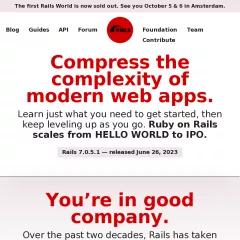Ruby on Rails 
Ruby on Rails is used by 0.87% of sites
Official Website
https://rubyonrails.orgCategory
Web Frameworks
Ruby on Rails, often referred to as Rails or RoR, is an open-source web application framework written in Ruby programming language. It follows the Model-View-Controller (MVC) architectural pattern and provides a framework for building robust and scalable web applications.
Key features and concepts of Ruby on Rails include:
Convention over Configuration: Rails follows the principle of "Convention over Configuration," which means that the framework makes assumptions about the best practices and conventions, reducing the need for explicit configuration. This allows developers to focus more on writing application code rather than spending time on repetitive setup tasks.
MVC Architecture: Ruby on Rails follows the Model-View-Controller (MVC) architectural pattern. The model represents the data and business logic, the view handles the presentation and user interface, and the controller manages the flow of data between the model and the view.
ActiveRecord: Rails includes ActiveRecord, an object-relational mapping (ORM) library that simplifies database interactions. It provides an easy-to-use interface for defining and manipulating database records using Ruby classes.
Routing: Rails provides a routing system that maps incoming HTTP requests to appropriate controller actions. It helps in defining custom routes, handling URL patterns, and creating RESTful APIs.
Scaffolding: Rails includes a scaffolding feature that generates a set of model, view, and controller code for a resource automatically. This feature provides a quick way to create CRUD (Create, Read, Update, Delete) functionality for database-backed resources.
Gems and Libraries: Rails has a vast ecosystem of gems (libraries) that can be easily integrated into applications to add additional functionality. Gems can range from authentication and authorization solutions to caching, testing, and more.
Testing Framework: Rails comes with a built-in testing framework called Minitest, which provides support for writing unit tests, integration tests, and system tests. It encourages developers to follow test-driven development (TDD) practices.
Strong Community and Documentation: Ruby on Rails has a strong and active community of developers. There are numerous resources, forums, and documentation available to assist developers in learning and solving problems.
Rapid Development: Rails is known for its focus on developer productivity and rapid application development. By providing a set of conventions, abstractions, and generators, Rails minimizes boilerplate code and speeds up the development process.
Scalability and Performance: Ruby on Rails is designed to scale and handle high traffic applications. With the use of caching mechanisms, database optimization techniques, and deployment strategies, Rails can support applications with significant user loads.
Ruby on Rails has been widely adopted by developers and companies around the world for building web applications of various sizes and complexities. It emphasizes code simplicity, developer productivity, and the "DRY" (Don't Repeat Yourself) principle, making it a popular choice for startups, small businesses, and enterprise-level applications.
Key features and concepts of Ruby on Rails include:
Convention over Configuration: Rails follows the principle of "Convention over Configuration," which means that the framework makes assumptions about the best practices and conventions, reducing the need for explicit configuration. This allows developers to focus more on writing application code rather than spending time on repetitive setup tasks.
MVC Architecture: Ruby on Rails follows the Model-View-Controller (MVC) architectural pattern. The model represents the data and business logic, the view handles the presentation and user interface, and the controller manages the flow of data between the model and the view.
ActiveRecord: Rails includes ActiveRecord, an object-relational mapping (ORM) library that simplifies database interactions. It provides an easy-to-use interface for defining and manipulating database records using Ruby classes.
Routing: Rails provides a routing system that maps incoming HTTP requests to appropriate controller actions. It helps in defining custom routes, handling URL patterns, and creating RESTful APIs.
Scaffolding: Rails includes a scaffolding feature that generates a set of model, view, and controller code for a resource automatically. This feature provides a quick way to create CRUD (Create, Read, Update, Delete) functionality for database-backed resources.
Gems and Libraries: Rails has a vast ecosystem of gems (libraries) that can be easily integrated into applications to add additional functionality. Gems can range from authentication and authorization solutions to caching, testing, and more.
Testing Framework: Rails comes with a built-in testing framework called Minitest, which provides support for writing unit tests, integration tests, and system tests. It encourages developers to follow test-driven development (TDD) practices.
Strong Community and Documentation: Ruby on Rails has a strong and active community of developers. There are numerous resources, forums, and documentation available to assist developers in learning and solving problems.
Rapid Development: Rails is known for its focus on developer productivity and rapid application development. By providing a set of conventions, abstractions, and generators, Rails minimizes boilerplate code and speeds up the development process.
Scalability and Performance: Ruby on Rails is designed to scale and handle high traffic applications. With the use of caching mechanisms, database optimization techniques, and deployment strategies, Rails can support applications with significant user loads.
Ruby on Rails has been widely adopted by developers and companies around the world for building web applications of various sizes and complexities. It emphasizes code simplicity, developer productivity, and the "DRY" (Don't Repeat Yourself) principle, making it a popular choice for startups, small businesses, and enterprise-level applications.